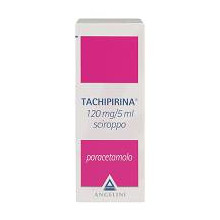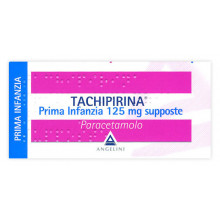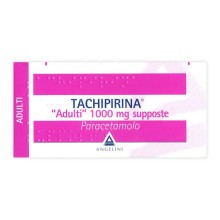TACHIFLUDEC * 10BUST ORANGE
Therapeutic indications
Short-term treatment of cold and flu symptoms, including mild / moderate pain and fever, when associated with nasal congestion.
Dosage and method of use
Dosage Adults and children over 12 years:1 sachet every 4-6 hours and up to a maximum of 3 sachets in 24 hours. The medicine should not be used for more than 3 consecutive days without consulting your doctor.Pediatric populationChildren under 12 years: TACHIFLUDEC orange flavor is contraindicated in children under 12 years of age (see section 4.3).Method of administrationDissolve the contents of one sachet in a glass of hot or cold water and sweeten as desired. Once dissolved, the medicine gives rise to a yellow opalescent solution, free from foreign particles and with an orange flavor.
Contraindications
- Children under the age of 12. - Hypersensitivity to the active substances or to any of the excipients (listed in section 6.1). - Patients taking beta-blockers. - Patients taking tricyclic antidepressants and those taking or have taken monoamine oxidase inhibitors within the last 2 weeks. - Patients with bronchial asthma, pheochromocytoma, narrow-angle glaucoma, or who are taking other sympathetic mimetic medicines at the same time (such as decongestants, appetite suppressants and amphetamine-like psychostimulants). - Patients suffering from hepatic or renal insufficiency, diabetes, hyperthyroidism, hypertension and cardiovascular diseases. - Paracetamol-based products are contraindicated in patients with manifest insufficiency of glucose-6-phosphate dehydrogenase and in those suffering from severe haemolytic anemia. - Severe hepatocellular insufficiency.
Side effects
The following are the undesirable effects organized according to the MedDRA System and Organ classification. The frequency is defined as: very common (≥1 / 10), common (≥1 / 100 to
| System and Organ Classification /Frequency | Undesirable effect |
| Disorders of the blood and lymphatic system |
| Rare | Agranulocytosis¹, leukopenia¹, thrombocytopenia¹ |
| Not known | Anemia¹ |
| Disorders of the immune system |
| Rare | Allergic reactions1.2, hypersensitivity reactions1.2, anaphylaxis1.2 |
| Not known | Anaphylactic shock1, 2 |
| Metabolism and nutrition disorders |
| Common | Anorexia² |
| Psychiatric disorders |
| Very rare | Insomnia², nervousness², anxiety², restlessness², confusion², irritability² |
| Nervous system disorders |
| Very rare | Tremor², dizziness², headache² |
| Eye disorders |
| Not known | Mydriasis², acute angle-closure glaucoma² |
| Cardiac pathologies |
| Rare | Tachycardia², palpitations² |
| Vascular pathologies |
| Not known | Hypertension² |
| Respiratory, thoracic and mediastinal disorders |
| Rare | Bronchospasm1.2 |
| Not known | Edema of the larynx¹ |
| Gastrointestinal disorders |
| Common | Nausea², vomiting² |
| Not known | Diarrhea¹, gastrointestinal pathology¹ |
| Hepatobiliary disorders |
| Rare | Abnormal liver function¹ |
| Not known | Liver disease¹, hepatitis¹ |
| Skin and subcutaneous tissue disorders |
| Rare | Rash1.2, angioedema² |
| Not known | Toxic epidermal necrolysis¹, Steven Johnson syndrome¹, erythema multiforme or polymorphic¹ |
| Renal and urinary disorders |
| Very rare | Tubulointerstitial nephritis (after prolonged use of high-dose paracetamol) ¹ |
| Not known | Renal failure aggravated¹, haematuria¹, anuria¹ urine retention² |
Very rare cases of severe skin reactions have been reported. ¹ Undesirable effects associated with paracetamol ² Undesirable effects associated with phenylephrineReporting of suspected adverse reactionsReporting of suspected adverse reactions that occur after authorization of the medicine is important, as it allows continuous monitoring of the benefit / risk ratio of the medicine. Healthcare professionals are asked to report any suspected adverse reactions via the national reporting systemhttps://www.aifa.gov.it/content/segnalazioni-reazioni-avverse.
Special warnings
Patients should be advised not to take other paracetamol-containing medicines while taking TACHIFLUDEC as high doses of paracetamol can cause serious adverse reactions. Avoid the consumption of alcohol during treatment with TACHIFLUDEC. The danger of overdose is in fact greater in patients with liver problems. Instruct the patient to contact their physician before combining warfarin or any other drug (see also section 4.5). The use of the product is not recommended if the patient is being treated with anti-inflammatories. Caution is advised if paracetamol is co-administered with flucloxacillin due to the increased risk of high anion gap metabolic acidosis (HAGMA), particularly in patients with severe renal impairment, sepsis, malnutrition and other sources of glutathione deficiency (e.g. eg chronic alcoholism), as well as in those using the maximum daily doses of paracetamol. Close monitoring, including measurement of urinary 5-oxoproline, is recommended. Consult your doctor before using the product in patients with enlarged prostate gland or occlusive vascular disease (eg Raynaud's syndrome). Do not exceed the recommended dose and do not administer for more than 3 consecutive days. TACHIFLUDEC orange flavor contains: -sodium:This medicinal product contains 135.82 mg sodium per sachet, equivalent to 6.79% of the WHO recommended maximum daily intake of 2 g sodium for an adult, to be taken into account in patients with reduced kidney function or who are on a low sodium diet. -sucrose:Patients with rare hereditary problems of fructose intolerance, glucose-galactose malabsorption or sucrase isomaltase insufficiency should not take this medicine. Patients with diabetes should take into account the sucrose content within TACHIFLUDEC when taking more than 2 sachets per day (sucrose> 5g). -glucose:Patients with rare glucose-galactose malabsorption problems should not take this medicine.
Pregnancy and breastfeeding
PREGNANCY Paracetamol A large amount of data on pregnant women indicate neither malformative nor fetal / neonatal toxicity. Epidemiological studies of neurodevelopmental in children exposed to paracetamol in utero show inconclusive results. If clinically necessary, paracetamol can be used during pregnancy, however it should be used at the lowest effective dose for the shortest possible time and at the lowest possible frequency. Epidemiological studies in pregnant women have shown that there are no contraindications to the use of paracetamol when used in the recommended doses, but the administration of the preparation in pregnancy and lactation must take place under the direct supervision of the doctor. Phenylephrine There are limited data from the use of phenylephrine in pregnancy. Vasoconstriction of the uterine vessels and reduced uterine blood flow associated with the use of phenylephrine can result in fetal hypoxia. The use of phenylephrine in pregnancy should be avoided as further information is needed. Ascorbic acid There are no controlled data on use in pregnancy. The use of ascorbic acid in pregnancy is only recommended when the benefit outweighs the risk. FEEDING TIME Paracetamol Paracetamol is excreted in breast milk but in clinically insignificant quantities. Available published data do not contraindicate its use during lactation. Phenylephrine There are no data on the excretion of phenylephrine in breast milk nor are there any information on the effects of phenylephrine on breast-fed infants. In the absence of available data, the use of phenylephrine should be avoided during lactation. Ascorbic acid Ascorbic acid is excreted in breast milk. Effects on breast-fed infants are not known. In summary, the use of TACHIFLUDEC is not recommended during pregnancy and lactation. FERTILITY There is no evidence in non-clinical studies indicating effects of paracetamol on male and female fertility at commonly used clinical doses. The effect of phenylephrine on male and female fertility has not been studied. There is sufficient evidence to indicate the importance of ascorbic acid at different levels in the reproductive process. However, no definitive human data on the clinical potential of vitamin C are available.
Expiration and retention
Store below 25 ° C. Store in the original container in order to protect the medicine from moisture and light.
Interactions with other drugs
Paracetamol The hepatotoxic effect of paracetamol can be enhanced by the intake of other drugs active on the liver, such as zidovudine and isoniazid which can produce an inhibition of the metabolism of paracetamol. Administration of probenecid before paracetamol decreases the clearance of paracetamol and the urinary elimination of paracetamol sulfate and paracetamol-glucuronide, and increases the half-life of paracetamol itself. Use with extreme caution and under strict control during chronic treatment with drugs that can determine the induction of hepatic monooxygenases or in case of exposure to substances that can have this effect (for example rifampicin, cimetidine, antiepileptics such as glutethimide, phenobarbital, carbamazepine) . Paracetamol increases the half-life of chloramphenicol. The product taken in high doses can enhance the effect of coumarin anticoagulants (warfarin). Metoclopramide and domperidone may increase the absorption of paracetamol, while it is reduced or delayed by cholestyramine and anticholinergics, respectively. Caution should be exercised when paracetamol is used concomitantly with flucloxacillin as concomitant intake has been associated with high anion gap metabolic acidosis, especially in patients with risk factors (see section 4.4). Phenylephrine Phenylephrine may antagonize the effect of beta-blocking and antihypertensive drugs (including debrisoquine, guanethidine, reserpine and methyldopa) and may potentiate the action of monoamine oxidase inhibitors (see section 4.3). The concomitant use of phenylephrine with tricyclic antidepressants or sympathetic mimetic amines may increase the risk of cardiovascular effects. Phenylephrine can interact with digoxin and cardiac glycosides increasing the risk of arrhythmia or heart attack, and with alkaloids (ergotamine and methylsergide) increasing the risk of ergotism. Ascorbic acid Ascorbic acid can increase the absorption of iron and estrogen. Ascorbic acid is metabolized to oxalate, and can potentially cause hyperoxaluria and kidney stones in patients through crystallization of calcium oxalate in patients who tend to form calcium stones. Interference with some laboratory tests The administration of paracetamol can interfere with the determination of uricaemia (by the phosphotungstic acid method) and with that of blood glucose (by the glucose-oxidase-peroxidase method). Ascorbic acid can interfere in the measurement of blood and urinary parameters (eg urate, glucose, bilirubin, hemoglobin).
Overdose
ParacetamolAt the recommended doses, or even if you were to take the entire pack, no symptoms of paracetamol overdose should appear. However, in the case of ingestion of very high doses of paracetamol (greater than 10 g), the most commonly encountered complication is liver damage, which usually occurs 12-48 hours after intake.Risk factorsto. Long-term treatment with carbamazepine, phenobarbital, phenytoin, primidone, rifampicin, St. John's wort or other liver enzyme-inducing drugs; b. regular consumption of ethanol in quantities higher than those recommended; c. glutathione depletion (e.g. eating disorders, cystic fibrosis, HIV infection, starvation, cachexia).SymptomsEarly symptoms of acetaminophen overdose in the first 24 hours are paleness, nausea, vomiting, anorexia and abdominal pain. Abnormalities of glucose metabolism and metabolic acidosis may occur. In severe poisoning, liver failure can progress to encephalopathy, hemorrhage, hypoglycemia, brain edema, and death. Even in the absence of severe liver damage, acute renal failure with acute tubular necrosis, strongly suggested by flank pain, hematuria, and proteinuria, can develop even in the absence of severe liver damage. Cardiac arrhythmias and pancreatitis have been reported.TreatmentImmediate treatment is essential in the management of acetaminophen overdose. Despite a lack of significant initial symptoms, patients should be referred to the hospital urgently for immediate medical attention. Symptoms may be limited to nausea or vomiting and may not reflect the severity of the overdose or the risk of organ damage. Management must be in accordance with the treatment established by the guidelines. If the overdose has occurred within 1 hour, treatment with activated charcoal should be considered. The plasma concentration of paracetamol should be measured 4 hours or more after ingestion (initial concentrations are not reliable). N-acetylcysteine treatment can be used up to 24 hours after paracetamol ingestion, however, the maximum protective effect is achieved up to 8 hours after ingestion. The effectiveness of the antidote declines sharply after this period. If necessary, the patient should be given intravenous N-acetylcysteine, in line with the established dose regimen. If vomiting is not a problem, oral methionine may be a suitable alternative in more remote areas, outside the hospital. The management of patients presenting with severe hepatic dysfunction beyond 24 hours after ingestion should be discussed with the National Poison Control Center or with the liver unit.Phenylephrine SymptomsSymptoms of overdose caused by phenylephrine are irritability, headache and increased blood pressure. In severe cases, confusion, hallucinations, convulsions and arrhythmias may occur. However, the amount needed to produce severe phenylephrine toxicity would be greater than that related to paracetamol.TreatmentTreatment must be clinically appropriate. Severe hypertension must be treated with alpha blocking drugs such as phentolamine.Ascorbic acid SymptomsHigh doses of ascorbic acid (> 3000mg) can cause transient osmotic diarrhea and gastrointestinal effects such as nausea and abdominal discomfort. The effects of ascorbic acid overdose may be hidden by the severe liver toxicity caused by acetaminophen overdose.TreatmentTreatment should be clinically appropriate.
Active principles
Each sachet contains:Active principles:paracetamol 600 mg, ascorbic acid 40 mg and phenylephrine hydrochloride 10 mg (equal to phenylephrine 8.2 mg).Excipients with known effects: 2 g ofsucrose; 135.82 mg ofsodium; 33.25 mg ofglucose. For the full list of excipients see section 6.1.
Excipients
Sucrose, anhydrous citric acid,sodiumcitrate, corn starch,sodiumcyclamate, saccharinsodium, anhydrous colloidal silica, blood orange flavor, curcumin (E100), syrup ofglucosedried.

 Convenient and safe payments
Convenient and safe payments
 Shipping in 24h all over the world
Shipping in 24h all over the world
 Fast returns
Fast returns
 Pharmaceutical experience
Pharmaceutical experience

















